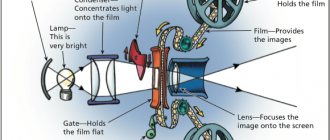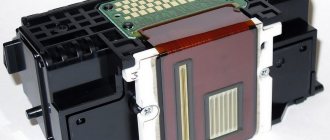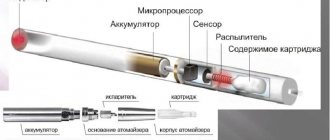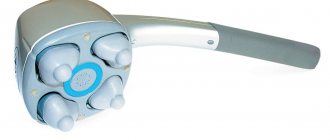Compared to cameras of yesteryear, digital cameras have very few mechanical components. They were replaced by electronic components. The only thing that has remained unchanged is the principle of obtaining a photograph, which is to transfer a visible image to some physical medium. In old cameras it was a light-sensitive film, and in modern digital devices it was the camera matrix. The article may be useful to those who are interested in photography not only as an art, but also want to understand some of the design features of cameras and the principles of image acquisition.
Formation of an image in the camera
Matrix, photosensor, sensor are the names of the same device that is part of the design of the camera and is its main element. By design, the matrix is a rectangular plate of different sizes made of chemically pure silicon, on which a large number of np junctions are arranged by vacuum deposition. These junctions are light-sensitive photodiodes or phototransistors. Thus, the matrix is an integrated circuit with several million light-sensitive elements. When light hits the photodiode, it is converted into an electrical signal. Depending on the subject, the amount of light may be greater or less. Electric potentials from the matrix are read line by line or element by element, then processed by the processor.
Types of matrices
Camera matrices can be manufactured using different technologies and have different sizes. The following types of sensors are used in cameras:
- CCD;
- CMOS;
- Live-MOS;
- 3 CCD.
The CCD matrix consists of semiconductor photodiodes, and the reading of electrical potentials is carried out along horizontal lines. CMOS field structures are much more economical, but due to electronic transformations during reading, the picture quality is somewhat worse than on a CCD matrix. Live-MOS is an advanced CMOS sensor. It is distinguished by increased sensitivity and fast signal transmission. The matrix uses a low noise amplifier and low voltage power supply. This is a Panasonic development, which is used in cameras from this company, as well as in Leica and Olympus cameras. The 3CCD or three-matrix sensor provides high-quality color reproduction with low noise. Color separation is carried out by a small dichroic prism with recording of each of the primary colors on a separate matrix. The disadvantages of the 3CCD system include the large size of the device and the high price of the camera.
| ISO-100, shutter speed 1 s. | |
| ISO-200, shutter speed 1/2 sec. | ISO-400, shutter speed 1/4 sec. |
So, by increasing the sensitivity to 400 units, we managed to shorten the shutter speed from 2 to 1/4 sec., i.e. almost 8 times! Great, isn't it? Everything is fine, if you don’t think that 1/4 is also not enough for shooting without a tripod. But in other cases, shortening the shutter speed by 8 times will really help, for example, from 1/10 to 1/80 sec. That's not the point now. Indeed, everything is fine if you do not pay attention to the noise. And if at ISO-50 there are almost no noises, and at 100 they are barely noticeable, then already at ISO-200 noise is visible quite clearly. However, some may find this acceptable, but at ISO-400, color mosaics become unpleasant, and for some, completely unbearable. To clearly understand the difference, look at the enlarged central parts of the images at ISO-50 and ISO-400. As they say, feel the difference!
| ISO-50, shutter speed 2 s. | ISO-400, shutter speed 1/4 sec. |
Of course, in low-light conditions, it is best to increase the shutter speed rather than the ISO. But as a rule, at long exposures, movement occurs (camera shake in the hands), and the movement blurs the picture. In our example, a tripod was used, and therefore for 2 sec. there was no lubrication. But it’s not always convenient to carry a tripod with you; as a result, you have to put up with noise on small sensors, and the number of megapixels will not help here. On the contrary, if you increase their number on a small matrix, this can lead to strong noise even at ISO-50 sensitivity.
You can often hear the question: “why does the compact make more noise at ISO 400 than the DSLR - after all, the ISOs are the same?” Yes, but their sensors are not the same: a SLR camera has a larger matrix size! And comparing ISO units in this case is not entirely correct; here you can only compare the noise level. And when we change the ISO in the camera settings, we do not change exactly the light sensitivity of the matrix (the sensitivity is set at the factory once and for all!), but only the level of the electrical signal - and, accordingly, the noise. Since the sensitivity of a larger matrix is initially higher, we get a better signal-to-noise ratio! It should be taken into account that matrices, of course, improve over the years, therefore:
!!! in more modern models there will either be less noise, or more pixels, or the price is lower. And vice versa:)
By tradition, we will (for convenience) say that we are changing the camera’s sensitivity. But no matter what terms you use, in any case ISO 3200 on a compact does not stand up to criticism... 
Let's now see how noisy a DSLR camera is. The following examples used a Pentax K10D, a very ancient (by digital standards) model, with a maximum ISO of 1600), photographed at night. Here are 4 pictures - at ISO-100, 400, 800 and 1600. I did not include ISO-200, it is almost no different from 100. Actually, in such small pictures they are all almost the same! And here it is almost impossible to compare (and even see!) the noise in the images shown within the 400 x 267 pixel previews. This is where the matrix size comes into play! Therefore, to see the difference, I recommend clicking on the photo and enlarging the size. You need to look for noises first of all in the sky, here they are easier to find :)
| ISO-100, shutter speed 4 s. | ISO-400, shutter speed 1 s. |
| ISO-800, shutter speed 1/2 sec. | ISO-1600, shutter speed 1/4 sec. |
What does noise depend on? From the size of the matrix and the number of megapixels, from the value of photosensitivity and even from the shutter speed. The smaller the matrix, the more megapixels, the higher the ISO and the longer the shutter speed, the more noticeable the color inclusions. If the camera's sensor gets very hot from prolonged use and/or heat, noise may become more noticeable, especially in dark areas of the image. Therefore, we cannot say that only megapixels or increased sensitivity produce strong noise - if favorable factors coincide, noise defects can be barely noticeable to the eye - even at maximum ISO!
In one of the letters I was asked the question: “Where do the materials come from? Kindly send me a link to the studio!” But I’m not a librarian - I’m just sharing my own experience, which I’m used to confirming with photographs (by the way, also my own). Here are 2 photos, one at ISO 100, the other at ISO 1600. The SLR camera is the same. Made during daylight hours with light snowfall. And a short shutter speed at ISO 100 and - especially - at ISO 1600. Even by clicking on the photo and loading full-size frames, it is not easy to notice significant differences!
| ISO-100, shutter speed 1/10 sec. | ISO-1600, shutter speed 1/180 s. |
I advise you to click on the photo and then enlarge it, otherwise you won’t immediately understand the difference... without this, the photos are almost indistinguishable... Let me remind you, we are talking about the sensitivity of ISO-100 versus ISO-1600! What about endurance? We managed to shorten it from 1/10 to 1/180 i.e. 18 times!! And this already makes it possible to freely shoot handheld without a tripod with minimal noise. However, here we could easily shoot at ISO-800 without a tripod with a shutter speed of 1/90 sec, and even at ISO 400 with 1/45 sec - for a wide angle this shutter speed is usually enough...
But this is a different kind of experiment. Below you see 2 home photos. Nothing special, the same tree, picture on the left without flash, on the right with flash. There is no enlargement, you don’t have to click the mouse - we’ll see the larger size a little later.
You can’t see any details in the small images, so we look at their enlarged central parts just below. Well, what can we say? 1 photo with very strong noise, in the second the noise is also noticeable, but there is an order of magnitude less of it. In general, we assume only three options. Now the author will tell us something like this: look at the different noises produced by a compact and a SLR camera with a sensor sensitivity of 400 units. Or, perhaps, vice versa: taken with the same camera, but with different ISOs. Or different cameras with different settings :) Which option is more correct?
In fact, both pictures were taken with the same SLR camera and... with the same ISO! Moreover, the shutter speeds are not long, and they are quite comparable, 1/30 and 1/45 sec. Why is there such a difference in noise? It's all about lighting. There is usually less noise in the light areas of the photograph, and more noise in the dark areas. Oh, by the way, in both pictures the photosensitivity is 1600 ISO! Let's look at the full size (it should be remembered that the color of the curtains was originally white, and even after photography it was not damaged)!
The conclusion is simple. Even on the same camera (with the same matrix), the same scene, shot at the same sensitivity, can produce a completely different number of color defects - noise!
Now we see how many factors influence noise in a digital camera, except for the size of the matrix, which we will get to later. And how many myths and conjectures are born when comparing images from different cameras at the same light sensitivity in order to determine which one is less noisy!
When they claim on forums that a DSLR from company A is noisier than a DSLR from company B, it makes you laugh, especially if the cameras (and their matrix!) are of the same price category and year of manufacture. Apparently, these people bought lenses from different companies, then, from time to time, buy the latest DSLRs from different manufacturers, and test them under the same conditions to prove: my camera (and company!) is the best... There's nothing to be done - this photo religion! Show these simple photographs to those arguing until they are hoarse, reconcile their sinful passions and dispel misconceptions to avoid religious bloodshed 
However, if new cameras (more precisely, new matrices!) appear, the quality of the image at high ISOs can really improve.
Over time, technologies develop, matrices improve, rivers flow, gardens bloom, and noise becomes less. There would be even fewer of them if the manufacturer did not simultaneously increase the number of megapixels (sensors)! This is only possible by reducing the intrinsic dimensions of these sensors so that they fit on the matrix. This seems to be normal, the color rendition does not get worse (sometimes even better), and in return we get the opportunity to enlarge the picture. True, it is not entirely clear why the user needs a matrix, say, 20 megapixels. I won’t believe that everyone prints huge posters, most don’t print anything at all!
I’ll give you a photo taken by a Pentax K5-II, a camera released in 2012 with a high-sensitivity sensor. This matrix still looks good in terms of photo latitude and noise level at high ISOs. If they had not increased the number of sensors and reduced their size, there would have been even less noise and more happiness!
ISO 3200, matrix of 16 heads, millions of sensors, image size 4928 x 3264
But even such a decision makes sense. In the subway, the lighting is always disgusting, people move with their minds and push, and the photo was taken handheld, without a tripod. Due to the high ISO, it was possible to achieve a shutter speed of 1/50 sec. Of course, there are noises at 3200, but if you don’t print at full size, they will be almost invisible, and even a gourmet won’t be able to see them on a 10x15 cm card. You know, there is a caste of gourmets who are considered great experts and connoisseurs of photography based on the presence of noise, or the presence of noise. 
I deliberately included a photo taken in combat conditions, and not under studio light, which other authors use (that’s strange!) when testing camera sensors for noise - in their extremely unbiased reviews 
With the right lighting, the results will, of course, be better. Even in normal daylight, noise can leave a blissful feeling of permissiveness from the “uselessness” of a flash and a tripod. Let's look at full-size frames (7 MB) taken with the above camera at ISO 3200 and 12800. Shooting handheld, flash off, focusing by "eye". The photo should be enlarged to see the noise. The easiest way to find them is in the background 
Light sensitivity 3200
Light sensitivity 12800
Actually, the matrix of this camera has a maximum sensitivity of 51200, but I don’t want to scare the reader with dirt in the pictures, from which the feeling of permissiveness smoothly flows into dull hopelessness and even a feeling of one’s own inferiority 
In life, despondency can only be cured with vodka by psychiatrists by taking responsibility for those who have been tamed (and we are trying to tame photography). And so, despite the huge sensitivity numbers, a strange desire arises to set the lowest ISO and overcome the long shutter speed - using a tripod, flash, or other lighting. Why do we need a matrix of 16 megapixels (there are many more) and dirty pictures?
The worst thing is when megapixels are increased in a “new” camera on an old matrix, and this is done purely for the sake of the world’s evil - marketing. Well, this is when the consumer is deceived by law 
Now let's look at the noise from a full-frame Canon EOS 6D camera, CMOS matrix 35.8 x 23.9 mm, pictures provided by an amateur photographer from the Krasnoyarsk Territory. Shooting handheld without a tripod.
| ISO-100 | ISO-1600 |
| ISO-6400 | ISO-25600 |
Having enlarged the photo, we see that ISO 6400 is quite working, and noise at 1600 is completely invisible. Even at ISO 25600 it is quite possible to print small photographs (say 10 x 15 cm), since the smaller the print size, the less defects are visible on it.
Watching noise is, of course, fascinating, but you shouldn’t get excited, especially if you compare photos of a DSLR and a compact. Yes, a DSLR is less noisy at ISO-800 than a compact camera at ISO-400. But we should not forget 2 things: 1. I took all the pictures of the compact and DSLR (except for the last examples) from a tripod - in this case, nothing prevents you from shooting with the compact at minimum ISO with minimal noise. 2. the value of a photo is determined primarily by its content, not its technical quality 
By the way, one should not blame the author for low-quality photographs that are dirty from noise. They only demonstrate what we are talking about, and it is about the size and photosensitivity of the matrix.
They only demonstrate what we are talking about, and it is about the size and photosensitivity of the matrix.
Matrix size
Size matters :) And very large - this is one of the main parameters of a digital camera. The same one that for some reason manufacturers don’t like to indicate. The size of the matrix is the sum of the sizes of the pixel sensors and the distance between them. It is these indicators that primarily determine the image resolution, the amount of noise, the depth of field... Everything is extremely important for the photographer: he loves high detail, does not favor noise, and wants to have a great opportunity to change the depth of field with the aperture. The latter directly depends on the size of the photosensor:
!!! The larger the size of the matrix in the camera, the shallower the depth of field in the photo!
I’ll translate the phrase into Russian: soap dishes and compacts provide sharpness from the navel to the very horizon (and that’s good!), and with a DSLR you can really adjust the depth of field, highlighting the main subject of shooting - which is even better. The size of the matrix speaks about this and about the dimensions of the cameras themselves: DSLRs have larger weight and dimensions.
The size of the matrix speaks about this and about the dimensions of the cameras themselves: DSLRs have larger weight and dimensions.
It is clear that a large matrix has larger pixels than a small one if the number of pixels remains the same. Here is a schematic diagram of 2 matrices, the first from a digital compact with a not very small matrix 7.2 x 5.3 mm (designation 1/1.8″), the second from a SLR camera 23.7 x 15.6 mm (designation “APS-C” - Advanced Photo System type- C). In fact, the number of square pixels in real cameras is much larger (for example, 16 million, not 48 as here), but the aspect ratios in the diagram are quite accurate for clarity.
With the same pixel density (here, for example, both matrices have 48 square pixels), the area of each pixel in a large matrix is larger, and accordingly, the light sensitivity and color rendition of a DSLR are much better (and there is less noise!). You can increase the number of pixels in two ways - increase the size of the matrix, or, on the contrary, you can reduce the area of the “squares” themselves so that more of them fit on the same matrix size. The first way is expensive, the second is cheaper, since you do not need to increase the matrix itself. Guess what path the manufacturer will take to proudly declare: our camera now has not 10, but as many as 20 megapixels!
More megapixels for image detail are, of course, good, but the fact that the area of each sensor has decreased is very bad. As a result, people are buying up marketing megapixels with all their might, without thinking about their origin. Here are examples of similar matrices with 48 cells and 192 cells (there are 4 times more megapixels!):
It is clear that in the second diagram the number of megapixels has been increased, while the area of each of them has been reduced. What else if the matrix remained the same size! And now compacts with 12 and even 16 megapixels are appearing, surpassing even other DSLRs in this regard. For example, the Nikon D50 SLR camera had only 6 megapixels - and this was enough for the eyes and ears, if you did not print large posters!
Digital cameras have long since crossed the “quality threshold” in terms of megapixels. Previously, a 2 megapixel camera was considered professional, and a 1 megapixel camera was considered amateur, and this one megapixel was clearly not enough for good detail. But the problem has long gone into oblivion, and speaking by and large, the number of notorious megapixels is no longer important at all. This quantity has long become excessive even in soap dishes. But other problems appeared! Increasing excess detail is now used more for marketing purposes, rather than for real improvement in quality.
Cunning sellers, and sometimes manufacturers, almost never indicate the dimensions of the matrices in millimeters, using instead incomprehensible designations in the so-called. “vidicon” inches, for example 1/2.5″, or 1/1.8″. The meaning of these “parrots” is that the larger the number in the denominator, the smaller the matrix, which completely confuses the inexperienced buyer. Especially the one who skipped fractions in school mathematics lessons. On a subconscious level, a person is always afraid of the incomprehensible, and having become completely confused, he is ready to swallow any bait from the seller.
“vidicon” inches, for example 1/2.5″, or 1/1.8″. The meaning of these “parrots” is that the larger the number in the denominator, the smaller the matrix, which completely confuses the inexperienced buyer. Especially the one who skipped fractions in school mathematics lessons. On a subconscious level, a person is always afraid of the incomprehensible, and having become completely confused, he is ready to swallow any bait from the seller. And about the megapixels that everyone understands - the more, the cooler, and about the price - the more expensive, the more prestigious, and about the design - “in a new fashionable case in an original color for the stylish and successful,” and other nonsense... Well, the growth curve of mental illness is rising higher and higher, immensely pleasing, for some reason, only private psychiatrists
And about the megapixels that everyone understands - the more, the cooler, and about the price - the more expensive, the more prestigious, and about the design - “in a new fashionable case in an original color for the stylish and successful,” and other nonsense... Well, the growth curve of mental illness is rising higher and higher, immensely pleasing, for some reason, only private psychiatrists
In fact, there is nothing wrong with these confusing numbers: before going to the store, you need to find the necessary information on the correct website and familiarize yourself with it in detail. How to find the most correct photo website?
How to find the most correct photo website? Out of false modesty, I will not send you to search Google, Yandex and other ramblers with the request “camera matrix size,” so you can safely continue reading further. To understand these inch designations, it is enough to see the corresponding sizes in millimeters in the table. The largest sensor (in 35 mm cameras) is called full frame, it has a sensor size of 36x24 mm.
Out of false modesty, I will not send you to search Google, Yandex and other ramblers with the request “camera matrix size,” so you can safely continue reading further. To understand these inch designations, it is enough to see the corresponding sizes in millimeters in the table. The largest sensor (in 35 mm cameras) is called full frame, it has a sensor size of 36x24 mm.
| Matrix. Dimensions. | ||||
| № | Camera model | Designation in inches | Die size mm | Crop |
| 1. | FED | film 35 mm | 36 x 24 | 1 |
| 2. | Nikon | "APS-C" | 23.7 x 15.6 | 1.5 |
| 3. | Pentax | "APS-C" | 23.5 x 15.7 | 1.5 |
| 4. | Sony | "APS-C" | 23.6 x 15.8 | 1.5 |
| 5. | Canon | "APS-C" | 22.3 x 14.9 | 1.6 |
| 6. | Olympus | 4/3 | 18.3 x 13.0 | 2 |
| 7. | compact | 1″ | 12.8 x 9.6 | 2.7 |
| 8. | compact | 2/3″ | 8.8 x 6.6 | 4 |
| 9. | compact | 1/1.8″ | 7.2 x 5.3 | 4.8 |
| 10. | compact | 1/2″ | 6.4 x 4.8 | 5.6 |
| 11. | compact | 1/2.3″ | 6.16 x 4.62 | 6 |
| 12. | compact | 1/2.5″ | 5.8 x 4.3 | 6.2 |
| 13. | compact | 1/2.7″ | 5.4 x 4.0 | 6.7 |
| 14. | compact | 1/3″ | 4.8 x 3.6 | 7.5 |
I repeat: it is not at all necessary to remember and keep all this information in your head. It's easy enough to understand that 1/1.8 is larger than, say, 1/3, but significantly smaller than APS-C size. You don't even need a calculator here. 
To better imagine these inches, millimeters, crops and other digital sizes, look at a picture that clearly depicts the ratio of the sizes of SLR and compact cameras. Matrices in soap dishes, as a rule, have sizes from 1/3″ to 1/2″ (the most popular and minimal value now is 1/2.3), in more expensive and advanced digital compacts from 1/1.8″ or more.
This, of course, is a very arbitrary division, but it is better to compare cameras by matrix size rather than by megapixels. The large rectangle shows the largest size available in 35mm format. The smaller blue rectangle will tell you about cropped DSLRs, the green one - about the 4/3 format, and the smallest 3 squares are matrices of different classes of digital compacts and point-and-shoot cameras. The letter k stands for crop factor. Those. How many times is this matrix smaller than the full frame?
You don't need to memorize all these numbers; it's enough to have a rough idea of what you're buying. So see clearly what real sensitivity (and not ISO units) awaits you, what noise there will be and what the weight with dimensions is. Large sensors have less depth of field than small ones, which means it’s easier to achieve the background blur effect - feel it! And with a large sensor size, the lens mounted on the camera will be wider-angle than the one mounted on the APS-C crop (“cropped” full frame), and when cropped, it will become longer-focus – feel this fact too! Yes! The proportions of rectangles speak precisely about this, and not just about crops, pixels, matrix sizes and other rubbish information that is far from photographic art and creativity.
So see clearly what real sensitivity (and not ISO units) awaits you, what noise there will be and what the weight with dimensions is. Large sensors have less depth of field than small ones, which means it’s easier to achieve the background blur effect - feel it! And with a large sensor size, the lens mounted on the camera will be wider-angle than the one mounted on the APS-C crop (“cropped” full frame), and when cropped, it will become longer-focus – feel this fact too! Yes! The proportions of rectangles speak precisely about this, and not just about crops, pixels, matrix sizes and other rubbish information that is far from photographic art and creativity.
By the way, these rectangles also talk about cost! When they authoritatively say that the price of a DSLR has dropped to the size of top-end compacts, they forget to say that this is the cheapest DSLR from the amateur class, and at the same time they do not mention the difference in price of top-end DSLRs and soap dishes of the lower range for 2-3 thousand rubles - and this is the difference huge In general, look and compare for yourself!
When they authoritatively say that the price of a DSLR has dropped to the size of top-end compacts, they forget to say that this is the cheapest DSLR from the amateur class, and at the same time they do not mention the difference in price of top-end DSLRs and soap dishes of the lower range for 2-3 thousand rubles - and this is the difference huge In general, look and compare for yourself!
The smallest matrix is found in mobile phone cameras. Here is a sample advertisement from a Toshiba mobile phone camera:
“Toshiba has announced that it has updated and expanded its range of Dynastron CCDs for use in mobile phones and communicators. The two new models, the 3.2-megapixel ET8EE6-AS and 2-megapixel ET8EF2-AS, represent significant progress in reducing the size of CCDs for mobile phones and other camera-equipped devices. Both new CCD models represent a significant step forward in miniaturization while maintaining high resolution. The ET8EE6-AS sensor is a 3.2-megapixel CCD sensor with a 1/3.2 optical format size, surpassing the company's previous achievement of a 1/2.6-inch format size.” By the way, an even smaller format has already appeared - 1/4 inch.
That's it - “significant progress in reducing the size of CCD matrices”! However, this is relevant for mobile phones; no one needs a bulky mobile phone, and a photo in it is an optional additional feature. A mobile phone must be truly mobile! But we are talking about a camera - and the larger the matrix, the larger the dimensions and weight of the device. It `s naturally. Is a small camera any good? It's not the same for everybody. Many people like a camera that fits in their breast pocket. However, not everyone considers large size to be a disadvantage. The weight and grip of the camera ensure better grip in your hands, resulting in less movement... You must admit that holding a small camera with two hands is inconvenient, but you have to hold it with one and press the start button - camera shake (and blurry pictures!) is almost guaranteed. What's more important? The answer may be this: it’s still a camera, not a mobile phone!
The matrices in DSLRs are much larger. In the pictures below we can compare the matrix sizes of compacts and SLR cameras. The SLR camera is equipped mainly with an APS-C format matrix, which has dimensions of 22.7 x 15.1, or 23.7 x 15.6 mm.
compacts
1/3.2″ 1/2.7″ 1/2.5″ 1/1.8″ 2/3″
Compacts and soap dishes are small in size, weight and reasonable price. This is their main, main and, perhaps, only advantage. 
cropped DSLRs
The matrix of such DSLRs is much larger than that of compacts, but, nevertheless, these DSLRs are called a “camera with a cropped matrix”, a camera with a cut-down sensor, or even a cropped one...
Do you think the matrix was “cut” to reduce the size of the camera, or to make it cheaper? No, this is just an attempt to reduce the cost of production and leave the sales price at the same level. In general, the matrices were made smaller than a film frame. The pictures show a 4/3 format sensor (mostly Olympus DSLRs), and next to it is an APS-C format - Nikon D50, Canon EOS 400D, Pentax K10D and many others. The first ones are 2 times smaller than full-frame matrices, APS-C - 1.5-1.6 times smaller. Alas, for some reason such cameras are not smaller in size than film SLRs! What else? For APS-C cameras, they often produce a “digital” lens with a smaller light coverage area, but you can also use old “film” optics - if the bayonet mount (mounting the lens to the camera) allows it. It should be remembered that when using non-autofocus lenses, you will have to focus manually.
No, this is just an attempt to reduce the cost of production and leave the sales price at the same level. In general, the matrices were made smaller than a film frame. The pictures show a 4/3 format sensor (mostly Olympus DSLRs), and next to it is an APS-C format - Nikon D50, Canon EOS 400D, Pentax K10D and many others. The first ones are 2 times smaller than full-frame matrices, APS-C - 1.5-1.6 times smaller. Alas, for some reason such cameras are not smaller in size than film SLRs! What else? For APS-C cameras, they often produce a “digital” lens with a smaller light coverage area, but you can also use old “film” optics - if the bayonet mount (mounting the lens to the camera) allows it. It should be remembered that when using non-autofocus lenses, you will have to focus manually.
full frame DSLRs 36×24 mm
As a rule, very expensive professional cameras have a larger sensor; their matrix size is the same as that of a film frame: 36 x 24 mm. It’s interesting that they began to be produced later than digital point-and-shoot cameras and even later than cropped digital SLRs. For matrices with a larger area, a lens covering this area is required, in this case a full-frame lens (for example, film optics). But it won’t work the other way around . a small lens for cropped cameras cannot be used on a full-size sensor...
It’s interesting that they began to be produced later than digital point-and-shoot cameras and even later than cropped digital SLRs. For matrices with a larger area, a lens covering this area is required, in this case a full-frame lens (for example, film optics). But it won’t work the other way around . a small lens for cropped cameras cannot be used on a full-size sensor...
I am often asked the question: what happens when in the camera settings we select a smaller number of megapixels for shooting. Will this improve the image quality?
Of course no! The actual size of the matrix (and each pixel sensor) will not increase from this, don’t even think about it. You simply use the camera settings to reduce the number of IMAGE pixels in the file (as in a graphics editor on a computer), and at the same time you will lose the ability to crop or enlarge the photo. In return, you get a small file size, saving space on your memory card, which means you can shoot even more - so much that you don’t have to think about anything at all 
If your credo in photography is to press the shutter button as often as possible and get more quantity in return for quality, then this wonderful function is created just for you!
So, let's summarize. The larger the matrix, the more capabilities the camera has, both in terms of color reproduction, resolution, and print size. The price of a camera largely depends on the matrix.
Matrix type
Finally, we note that photomatrices differ not only in size, but also in type. There are the following types: - CCD (CCD). A charge-coupled device using light-sensitive photodiodes. The CCD was invented in 1969 and was originally used as a memory device, but the ability of the device to receive a charge due to the photoelectric effect made the use of CCDs primary in this direction. The CCD matrix is produced and used by many leading manufacturers, Sony has especially done a lot of work here. — CMOS matrices (CMOS). This technology uses transistors and is characterized by low power consumption. CMOS microcircuits were released back in 1968 and initially found application in calculators, electronic watches, and in general in those devices where power consumption was critical. — Live-MOS matrix. Has the ability to “live” image viewing. It is actively being developed by Panasonic; it was first used in DSLRs by Olympus in 2006 (Olympus E-330 camera). In 2009, almost all major manufacturers have SLR digital cameras with the ability to view on an LCD screen. In technical specifications, this feature is usually called “Live View”. There are others, for example, DX matrix, Nikon RGB matrix and other types of photosensors.
In addition, matrices differ in color production technology. The sensor itself does not perceive color, producing an image with shades of gray (more light/less light), and color filters are used to obtain colors. For example: - matrices with a Bayer filter
- Foveon X3 matrices - 3CCD.
This technology divides light across the spectrum using special prisms into red, green and blue. Moreover, each of them is sent to a separate matrix (the system is good for everyone, except for one thing - large dimensions!)
To achieve brighter images with lower noise levels, sensors are constantly evolving. Most technology solutions involve reducing unused sensor surface, optimizing control signals, and developing low noise amplifiers. However, one should not be afraid that photographers will soon begin to easily shoot with a point-and-shoot camera in pitch darkness. So that no one is too afraid, companies introduce new technologies very gradually, or do not introduce them at all and keep them secret until they suck all the money out of the consumer for the old ones. And it’s not at all funny and criminal when this story concerns not photographic equipment, but medicines for dying of cancer...
Most technology solutions involve reducing unused sensor surface, optimizing control signals, and developing low noise amplifiers. However, one should not be afraid that photographers will soon begin to easily shoot with a point-and-shoot camera in pitch darkness. So that no one is too afraid, companies introduce new technologies very gradually, or do not introduce them at all and keep them secret until they suck all the money out of the consumer for the old ones. And it’s not at all funny and criminal when this story concerns not photographic equipment, but medicines for dying of cancer...
We will not consider in more detail the types of sensors, their differences and the differences in color filters. This may be very important for matrix manufacturers and their technicians, but not for photographers, because there will be no noticeable difference in the pictures themselves. I would advise amateur photographers to pay more attention to seeing (primarily with their eyes!) interesting scenes and beautiful shooting angles. After all, this site was intended to help novice photographers, not techies!
Important characteristics of matrices
The semiconductor matrix of a digital camera has a number of basic characteristics on which the image quality depends. These are the following parameters:
- Size
- Number of pixels
- Sensitivity
- Dynamic range
- Signal to noise ratio
Additional characteristics include supply voltage and power consumption. They do not affect the picture and are usually not indicated in the camera description.
Crop factor
This is the main parameter of the semiconductor matrix. The most important characteristics of the image captured by the camera depend on it, and to a lesser extent on the number of pixels. The crop factor is a number that shows how much smaller the real matrix is than the full-frame standard. Full Frame is a matrix size of 24 X 36 mm. The most expensive and professional cameras are equipped with such sensors. This size corresponds to a frame on standard film. To reduce the cost of photographic equipment, as well as for the production of compact and lightweight amateur point-and-shoot cameras, small matrices are used.
There is a generally accepted number of formats for photosensitive matrices. Full-frame sensors are followed by a size of 16 x 24 mm, which corresponds to a crop factor of 1.5. The smallest sensors used in inexpensive cameras are matrices with dimensions of 4.5 x 3.4 mm. This is a crop factor of 7.6. They are used in cheap camera models where high frame quality is not required.
Resolution, megapixels
Camera sellers usually boast about the number of megapixels when they offer products to novice amateur photographers. This option should be used with caution. The frame of a digital camera consists of miniature semiconductor elements. Each pixel is a subminiature photodiode or phototransistor. Theoretically, it turns out that the more pixels, the higher the image quality, the more precise the fine details or the resolution. In practice, a large number of pixels improves image quality only on large matrices.
If the crystal size is small, and the camera manufacturer managed to place a large number of photosensitive elements on it, then the image quality will be low. Very important for the matrix is not only the size of the individual photocells, but also the distance between them. Small distances lead to overheating of the matrix and an increase in digital noise, which is characterized by colored dots throughout the image. In addition, when the camera lens is stopped down too much, due to diffraction, a color fringe will appear around the image elements. Therefore, a frame taken on a camera with a matrix of 5.4 x 4.0 mm and 16 megapixels will be much worse than a picture taken on a camera with a matrix of 8.8 x 6.6 mm and 10 megapixels. It is believed that, in cameras, exceeding the number of megapixels over 25 will be unnecessary. This is partly due to the resolution of photo printers, with the most advanced models printing photos with a resolution of 9,600 X 2,400 pixels, which corresponds to 23.4 megapixels.
Photosensitivity
This parameter in digital cameras is a relative value. A silicon wafer with photosensitive elements has constant sensitivity. It's all about the signal levels that come from the photodiodes for further conversion. If little light reaches the camera sensor, the electrical signal from it will be weak and the photo will be dark. In order to make the image lighter, a weak signal can be amplified. The variable gain is the sensitivity of the camera. For the convenience of photographers, the sensitivity of the matrix is expressed in the same units as the Western standard for photographic materials ASA. The ratio of ISO sensitivity and domestic photographic films is as follows:
- 50 – 45;
- 64 – 65;
- 100 – 90;
- 160 – 130;
- 320 – 250.
In the left column is the sensitivity of the camera, and in the right is the sensitivity of the film according to GOST.
Signal to noise ratio
Small colored dots in the image occur for various reasons. First of all, the matrix itself, even in the absence of illumination, will produce a weak electrical potential. This is noise. In order for it not to affect the image, the level of the useful signal must be much higher than the noise level. The noise characteristics of the matrix increase with decreasing pixel size and the distance between individual points. Therefore, the lowest-quality picture will be the one obtained on a small sensor with a large number of megapixels. Camera noise increases noticeably as gain or sensitivity increases. Therefore, if possible, it is recommended to shoot at minimum sensitivity. Heating the camera matrix has a negative effect on image quality. This happens when it is constantly working, displaying an image on the display. Professionals try to work with the camera's optical viewfinder. In this case, power is supplied to the matrix only for a very short time, and it does not have time to heat up.
Dynamic range
This parameter is determined by the gap between the minimum and maximum exposure values, which are clearly visible in the image. If the camera has a dynamic range of 8 stops or EV, then the image will show objects that differ in brightness by 256 (28) times. All objects whose brightness is higher will turn out completely white. The lower threshold is determined by the noise level of the matrix itself, and the upper threshold is determined by the maximum electrical charge of the photodiode.
The Heart of the Digital Camera: The CCD (Part Two)
In such sensors, next to each column (which is a serial shift register) there is a buffer column (also a serial shift register), consisting of CCD elements covered with opaque strips (usually metal). The set of buffer columns makes up a buffer parallel register, and the columns of this register are “mixed” with the columns that register light.
In one operating cycle, the photosensitive parallel shift register transfers all its photocurrents to the buffer parallel register by “horizontally shifting” the charges, after which the photosensitive part is again ready for exposure. Then there is a row-by-row “vertical shift” of the charges of the buffer parallel register, the bottom row of which is the input of the serial matrix shift register.
Obviously, transferring the charge of the matrix to the buffer parallel shift register takes a short time interval and there is no need to block the light flux with a mechanical shutter - the wells will not have time to overflow. On the other hand, the required exposure time is usually comparable to the time it takes to read the entire buffer parallel register. Due to this, the interval between exposures can be reduced to a minimum - as a result, the video signal in modern video cameras is generated at a frequency of 30 frames per second and higher.
In turn, column-buffered sensors are divided into two categories. When reading all rows in one clock cycle, we can talk about a matrix with progressive scanning (progressive scan). When odd lines are read in the first clock cycle, and even lines in the second (or vice versa), we are talking about an interlace scan matrix. By the way, due to the similarity in the sound of the English terms “matrix with column buffering” (interlined) and “interlaced matrix” (interlaced), in domestic literature sensors with row buffering are often mistakenly called interlaced.
Oddly enough, charge “smearing” also occurs in matrices with column buffering. This is caused by the partial flow of electrons from the potential well of the photosensitive CCD element into the potential well of a nearby buffer element. This occurs especially often at photocurrent levels close to maximum, caused by very high pixel illumination. As a result, a light strip stretches up and down from this bright point in the photo, which spoils the frame.
To counteract this phenomenon, the distance between the photosensitive and buffer CCD elements is increased. As a result, the charge exchange becomes more complicated and the time spent on this increases, but frame distortions caused by “smearing” are still too noticeable to be neglected.
Column buffering also makes it possible to implement an electronic shutter, which can be used to avoid mechanical blocking of the light flux. Using an electronic shutter, you can achieve ultra-short (up to 1/10000 of a second) shutter speeds that are unattainable with a mechanical shutter. This feature is especially relevant when photographing sports competitions, natural phenomena, etc.
To implement an electronic shutter, anti-blooming drainage is required. At very short shutter speeds, which are shorter in duration than the time of charge transfer from the potential well of the photosensitive CCD element to the potential well of the buffer, drainage plays the role of a “cut-off”. This “cutoff” prevents electrons generated in the well of the photosensitive element after the exposure time from entering the well of the CCD buffer element.
However, the column buffering scheme is not without its drawbacks. The main disadvantage is that shift buffer registers “eat up” a significant part of the matrix area, as a result, each pixel only gets 30% of its total surface as a light-sensitive area. For a full-frame sensor pixel, this area is 70%.
To compensate for this disadvantage, manufacturers use microlenses located above each element of the matrix and focusing the entire light flux reaching the pixel onto a relatively small photosensitive area.
Which camera to choose
If you want to shoot everything without thinking about the high quality of the image, you can purchase any compact or point-and-shoot camera. The absence of manual modes, a large number of scene programs and focusing on faces makes this camera easy to use and convenient for everyday use. To obtain high-quality images, an inexpensive camera with a larger matrix and the ability to manually set some shooting parameters is suitable. The mirrorless superzoom camera provides even more possibilities to the user. Being small in size, it allows you to shoot interesting scenes at a great distance from the subject, so it is suitable for tourists and travelers. The highest quality images are obtained with a DSLR camera, although its use is limited by its large size and weight. If you want to know all the nuances of choosing a camera, our experts have prepared detailed instructions in the article on how to choose a camera.
Types of camera matrices and their differences
Categories: Photographic equipmentPhotography stylesDo it yourselfEditingTheory
One of the important factors that matters when choosing a camera is the type of matrix, which is the main structural element. It is a sensor device, the main feature of which is high sensitivity. Thanks to the design and operation of the matrix, the optical signal is transformed into a different quality - it becomes a digital image. The type of matrix and its quality determine the level of photographs.
This element of the camera design looks like a rectangular plate made of semiconductor material. There are a huge number of pixels (millions) on the surface of the plate. Each pixel is located separately from each other. Their purpose is to form one point in the image. Each matrix has certain physical dimensions; the larger they are, the better the quality of the image, even if the number of pixels is the same. Physical parameters include diagonal, area, width. They are measured in millimeters. Technical specifications do not always refer to physical parameters; more often, only the number of pixels is indicated. The size of the sensor affects the weight of the camera, as well as how it picks up digital noise.
Thus, the physical dimensions of the matrix determine the quality level of photographs, and the maximum image size depends on the number of pixels. Therefore, when buying a camera, you should not make the number of megapixels the main parameter.
There are different types of matrices depending on the type of filter - RGB (it is the most common type), RGBW (give beautiful pictures even in poor lighting), and with Baer RGBE (their feature is the maximum proximity of colors to natural ones, this is achieved thanks to large number of green pixels). According to the technology used, there are two types of matrix, one of the most important elements of cameras and video cameras. The first group is CCD matrices ( CCD ), the second is CMOS matrices ( CMOS ). The first group is installed specifically in cameras, and the second is also typical for the designs of telescopes and microscopes.
There are two groups based on the method of reading information from cells. In the matrix of CCD cameras, this information is read sequentially, and in the matrices of telescopes - separately from each cell. The difference can be seen even in the simplest example. With the CCD type, you cannot take pictures very quickly; it takes time for the previous photos to form. But the features of the CMOS matrix are excellent for autofocus, for exposure metering, as well as for regular photography. CMOS-type matrices require less energy to operate, and their production is much more economical and the price is more affordable.
There are also three-layer matrices, usually each layer is a CCD type. Their cells differ in that they can perceive three colors at once. These three colors are produced when light hits dichroid prisms. Then each beam falls on a matrix (each on a separate one). As a result, the brightness of three colors (blue, red and green) is determined immediately on the photocell. Three-dimensional matrices are used in the production of high-end video cameras. And equipment with such a matrix has a special designation - 3CCD .
CCD matrices are made of polysilicon photodiodes; they are small in size and allow for fairly high-quality photography in conditions with normal lighting. And for the production of CMOS matrices, complementary metal oxide semiconductor materials are used. Despite the high advantages of taking pictures using this element, there is also a disadvantage of the matrix - relatively large sizes. If photographic equipment is equipped with CMOS matrices, it will be heavier and larger.
Having studied the features of various types of matrix, you can now, even without being a strong expert in photographic equipment, understand why professional equipment that provides a high level of filming has large dimensions and weight. And the choice of camera should be made not according to the usual criterion, that is, by the number of pixels, but by the physical dimensions of the matrix. About the site fotomtv.
Other topics:
- Portrait lenses
- Phase and contrast autofocus
- About poses and styles in photography
- Depth of field
- How to make a camera obscura from a matchbox
- Diffuser (reflector) for built-in flash
- Stereo photography
- Portrait in photography
- Hair in photography
- Photography of corporate parties
- Camera shutter speed
- How to make a panorama using Adobe Photoshop
- Bokeh in photography (making heart-shaped bokeh)
- Reportage shooting
- Batteries for cameras
- Ambrotype - photograph on glass
- Lenses with creative filling
Show html code to embed in blog
Results
When choosing a camera, you should first focus on the size of the matrix. You should not chase a large number of points in the image. 12-16 megapixels is more than enough to receive and print good quality photos. Digital zoom is not very important for the camera, since it only allows you to stretch the central part of the image to fill the entire screen with deterioration in quality. Many parameters are not indicated in the specifications for the camera, so before choosing a model, it’s a good idea to read reviews from amateur photographers on special websites.
TECHNICAL SECURITY SYSTEMS
The matrix is one of the most complex devices of the camera, its main and, most often, its only sensory organ (there is also a temperature sensor). The matrix contains the best achievements in the field of microelectronics. The very word “matrix” means a move away from bulky electric vacuum monsters to miniature rectangular plates, with the help of which the nimble Chinese flooded the market with spy gadgets packaged in watches, buttons, fountain pens, etc. and so on.
Camera descriptions contain such harsh inscriptions as, say, SONY super HAD II CCD 1/3″ . This is certainly impressive, but you shouldn’t be guided by emotions when choosing a camera. Let's go through the parameters of the matrices at least superficially.
1/3″ - this is the most popular matrix size, it is tied to the diameter of the electron tube with similar parameters, i.e. goes back to the last century. It is enough to know that the larger the size, the higher the quality and price. Therefore, the sizes 1″, 1/2″, 2/3″ are used much less frequently in video surveillance due to the price (there are plenty of them in professional photography), although the quality is higher there. Also, matrices sized 1/4″ and below are used less frequently due to their lower quality. The fact is that with the same number of pixels (image elements), a larger matrix has better quality due to less noise induced by neighboring elements. Over time, the sizes will probably decrease, but for now that’s how it is.
About “SONY super HAD II CCD” - this is a technology for increasing the sensitivity of color cameras, developed by guess three times by whom. We won’t go into details; if you’re interested, use search engines or write a question in the comments. It is enough to know that now there are 2 main technologies: CCD (CCD) and CMOS (in the jargon - chmos), which in our opinion is respectively CCD (charge-coupled devices) and CMOS (complementary metal-oxide-conductor). But in reality, for the consumer:
— CCD (CCD) are of slightly higher quality, but more expensive;
- CMOS (CMOS) is a little cheaper, consumes less (not much).
Not so long ago, DIS (digital image system) technology appeared. There the matrix is assembled on one chip with a video signal processor. It didn’t make much of a revolution - the technologies are still the same. But there is one interesting effect - the temperature range of the matrix is wider towards negative temperatures (up to -40). As I understand it, it’s just that the processor, standing on the same chip with the matrix, heats it up - a side effect. But this allows us to abandon the heating device, and in our Siberian conditions this is very important. For example, at one object the cameras began to turn off in the evening (by the way, the same object that appears pictures” “Protection Class ”). Well, I figured it out, the point was that the resistance of the long thin wires caused the supply voltage of the cameras to drop almost to the limit, and in the evening, when the temperature dropped (it was in the fall), the heating was turned on, the current increased, and the voltage completely dropped - below the permissible threshold. So the cameras turned off. By the way, similar cases occur when the built-in infrared illumination is turned on in the dark. You just need to think when you design an object, and don’t mess around with the installation. Well, that's a different story.
Well, naturally, another significant parameter is the matrix resolution , i.e. number of pixels per line and number of lines. For analog cameras, the ultimate dream is limited by the parameters of the PAL - 720x576 pixels. So, if you insert a matrix of any megapixel into an analog camera, the image will remain within the specified limits. Of course, with proper signal processing, the quality will increase somewhat by taking into account the brightness and color of the pixels adjacent to the transmitted ones. In addition, by summing signals from neighboring pixels, sensitivity can be increased. IP cameras can produce an image corresponding to the resolution of the matrix, among them there are megapixel cameras, this is their indisputable advantage. They have their drawbacks, but that is a subject for another discussion.
The sensitivity of the matrices is the minimum illumination in lux (lux, a unit of illumination, international designation - lx), at which an object can be distinguished. At the moment it is close to the technological limit. Somewhere between tenths and hundredths of lux, as far as I remember. There are cameras with a sensitivity value of, say, 0.0001 lux. Here you need to be aware that it was achieved by sequentially summing images from several successive frames. This is done by the video signal processor and has nothing to do with the sensitivity of the matrix. In low light, a moving object will either be blurry or not noticeable at all. It should also be noted that in low light conditions, color matrices can switch to black and white image mode, and the RGB color signals (red, green, blue) are combined into a single luminance signal to increase sensitivity. Moreover, if the camera is equipped with an automatically retractable infrared filter that protects the matrix in the daytime, then the camera can work with infrared illumination, invisible to the naked eye.
By the way, our eye is designed in a similar way - there, on the retina, there are sensitive elements that perceive color, but with low sensitivity, and in the dark others are connected - highly sensitive, but black and white. Hence the statement that all cats are gray at night.
There is another serious parameter - dynamic range . This is the ratio of the brightest and darkest signals that the matrix can process simultaneously. This parameter is better for CCD matrices, but CMOS matrices are actively developing.
In general, there are many parameters, you need to choose based on your tasks, conditions and financial capabilities (I apologize for the banality). Contact specialists, you can contact me










